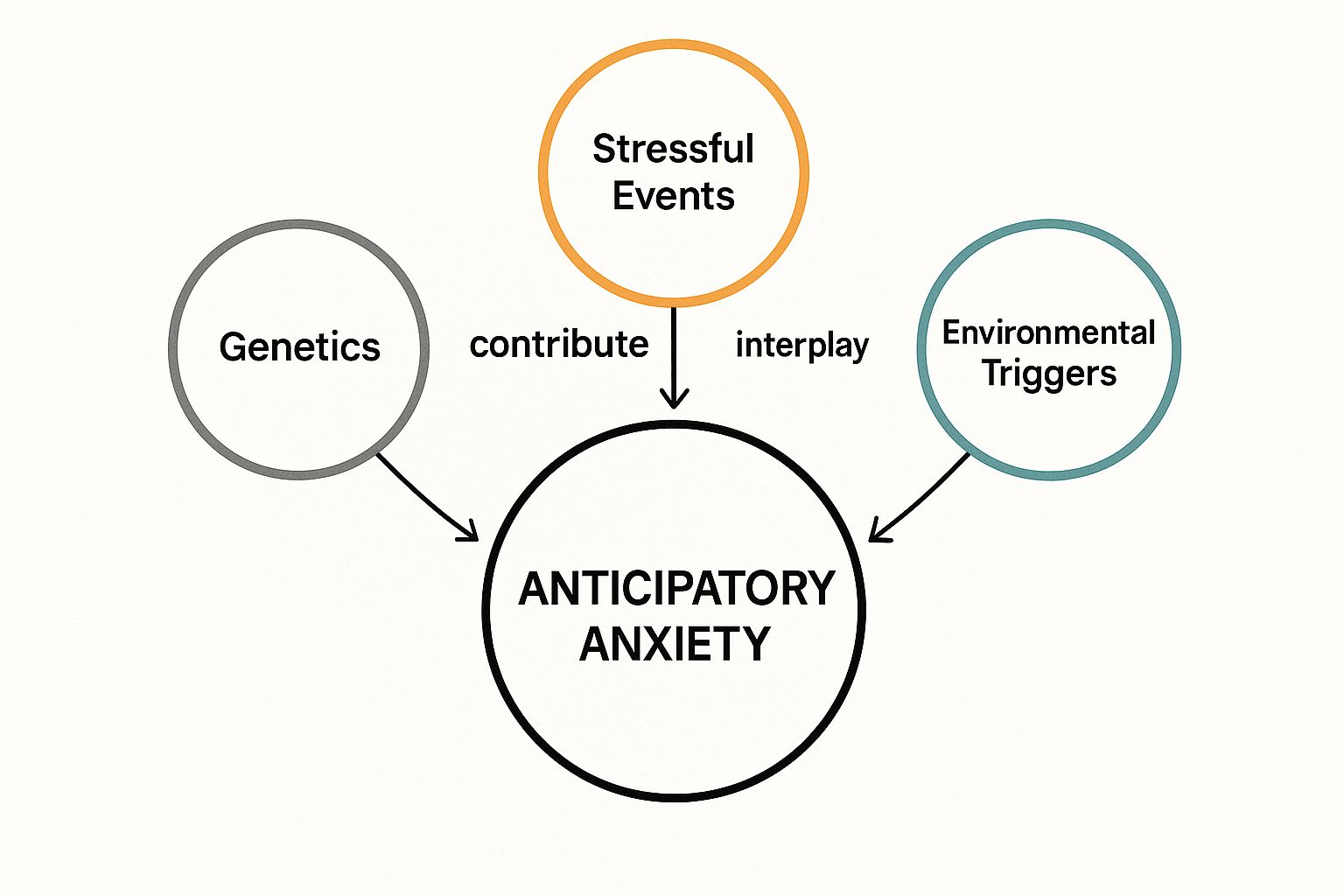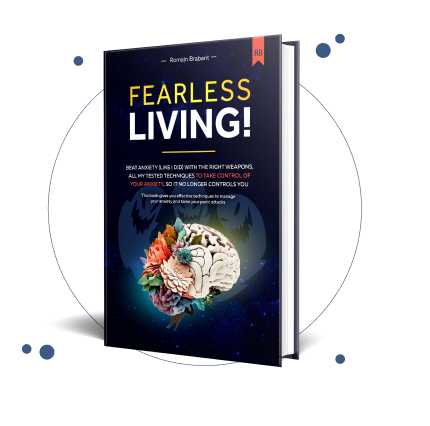
Anticipatory anxiety is that gut-wrenching dread you feel before something happens. It’s not just getting the jitters; it’s an intense "fear of the fear" that can make the days, weeks, or even months leading up to an event feel far worse than the event itself.
But here’s the most important thing to know: it’s manageable. Finding your way out of that cycle of worry and living a life free from panic is entirely possible.
The Constant Fear of What Might Happen

Ever had a knot in your stomach for days before a big presentation? A doctor's appointment? Even just a casual social gathering? Your mind starts spinning with endless "what if" scenarios, playing out every possible way things could go wrong. That right there is the heart of anticipatory anxiety.
It's a deeply human experience where your brain gets stuck in overdrive, constantly preparing for a threat that hasn't even arrived yet.
This state of high alert is draining, but you are not navigating it alone. It’s a common thread in many anxiety disorders, which affected an estimated 301 million people globally back in 2019. Getting familiar with the common causes of anxiety can be a powerful first step in seeing these patterns in your own life. You can learn more about the worldwide impact from the World Health Organization.
Here’s what’s most important to remember: Acknowledging this fear isn't a sign of weakness. It's the first real step toward taking back control. Your feelings are valid, and there is a clear and hopeful path forward to a calmer, more present life.
Our goal isn't to erase worry completely—that's not realistic. The goal is to learn how to manage it so it no longer runs the show. This guide is here to give you the understanding and the tools you need to reclaim your peace and prove to yourself that you can handle whatever comes next. Healing is possible, and a panic-free life is within your reach.
How Your Brain Creates Future-Focused Fear
At its core, anticipatory anxiety is a biological process—your brain’s ancient threat-detection system working a little too well. It’s like a home smoke detector that’s become overly sensitive. It’s designed to protect you, but it starts blaring at the slightest hint of smoke, unable to tell the difference between burning toast and a real fire.
Your brain has a similar system, with a small, almond-shaped region called the amygdala acting as its alarm. When you think about a future event that feels uncertain or threatening, the amygdala sounds the alarm, triggering a cascade of stress hormones. This is why a simple "what if" thought can produce such powerful physical sensations like a racing heart or a tight chest.
The challenge is that this system struggles to separate an imagined threat from a real one. Your body reacts to the thought of failing a presentation with the same fight-or-flight response it would use to face an actual, present danger.
The Science of 'What If' Spirals
This overactive response isn't a personal failing; it's rooted in complex brain networks. The Uncertainty and Anticipation Model of Anxiety (UAMA) explains that this future-focused fear is linked to how different parts of the brain communicate. Key areas responsible for evaluating threats, tagging emotional importance, and learning what is safe can become dysregulated, keeping you in a state of high alert. If you want to dive deeper into the science, you can read the full research on these brain networks.
This infographic shows how genetics, stressful events, and environmental triggers can contribute to this sensitivity.

As the visual highlights, these factors often interact, creating a cycle where past stress can amplify both genetic predispositions and reactions to current triggers.
Understanding this mechanism is the first step toward healing. It transforms anxiety from a mysterious monster into a biological process you can learn to influence and recalibrate.
Knowing that your brain is simply trying to protect you—even if its methods are outdated—empowers you to take the next step. You can learn to work with your brain, teaching it that you are safe and capable of handling what’s to come. This understanding paves the way for a panic-free life.
Recognizing Common Triggers in Your Daily Life

Anticipatory anxiety loves to latch onto specific situations, turning perfectly normal future events into sources of present-day dread. The first step toward breaking that cycle is simply learning to spot these triggers in your own life. It’s about connecting the dots between an upcoming event and the storm of worry you feel brewing inside.
For a lot of us, this anxiety shows up at work. You might spend the weeks before a performance review in a state of low-grade panic, your mind fixated on everything that could possibly go wrong. The inner monologue sounds a lot like, “What if my boss thinks I’m underperforming? What if I get a bad review and lose my job?” This isn't just a case of the jitters; it's a consuming fear that sabotages your focus and peace.
Social situations are another huge catalyst. Got a party on the calendar? The anxiety might start building days in advance. Thoughts like, “I won’t know anyone,” or “I’ll say something awkward and make a fool of myself,” can become so loud that you’re tempted to just cancel and stay home.
Pinpointing Your Personal Patterns
If any of this sounds familiar, you're not alone. These triggers are incredibly common. Research shows that career milestones, like job interviews, spark anticipatory anxiety in a staggering 42% of adults. The pressure of public speaking gets to 55% of us, while academic challenges trigger it in 63% of individuals. Even health concerns are a major factor, affecting 47% of patients before an appointment.
To help you see how these triggers play out, I've put together a table that breaks down a few common scenarios and the anxious thoughts that often come with them.
Recognizing Your Anticipatory Anxiety Triggers
| Triggering Situation | Common Anxious Thought Pattern |
|---|---|
| Upcoming Social Event | "I'll have nothing to say and everyone will judge me." |
| Work Presentation | "I'm going to forget my words and look completely incompetent." |
| Doctor's Appointment | "What if they find something seriously wrong with me?" |
| Difficult Conversation | "This is going to end in a huge argument and ruin everything." |
See any of your own thought patterns in there? Identifying which situations resonate most with you is empowering. It helps you see your anxiety not as some random, unpredictable wave of fear, but as a direct response to specific events.
This awareness is the foundation for your healing journey. Once you know your triggers, you can start building targeted coping strategies to reclaim your sense of calm. For a deeper dive, check out our guide on common anxiety triggers.
Actionable Strategies to Reclaim Your Peace
Knowing what’s behind your anticipatory anxiety is the first step. Learning how to respond when it shows up—that’s where you find your power. This is where you move from just understanding the problem to actively healing.
You can build a toolkit of simple, effective strategies to calm your nervous system and, over time, teach your brain that you can handle whatever comes next.
The goal isn't to get rid of worry forever. That's impossible. The goal is to stop it from running your life. These techniques are designed to pull you back into the present moment and break that relentless cycle of "what if" thinking, paving your way toward a panic-free life.
Ground Yourself in the Present Moment
When your mind is racing toward some feared future, the most powerful thing you can do is yank it back to right here, right now. Grounding techniques are simple sensory exercises that act like a pattern interrupt for anxious spirals, forcing your attention back to your immediate surroundings.
One of the most effective and discreet methods is the 5-4-3-2-1 technique. You can do it anywhere, anytime you feel that familiar dread start to creep in.
- 5 Things You Can See: Look around and name five distinct objects. Don't just list them; notice their color, shape, and texture. The scuff on your shoe, the grain of the wood on your desk, the way light hits a water glass.
- 4 Things You Can Feel: Tune into the physical sensations right now. It could be the solidness of the chair beneath you, the feeling of your feet flat on the floor, or the texture of your shirt against your skin.
- 3 Things You Can Hear: Listen closely for three specific sounds. Maybe it’s the low hum of your computer, birds chirping outside your window, or the faint sound of distant traffic.
- 2 Things You Can Smell: Identify two scents in your environment. It could be the coffee on your desk or the clean scent of soap on your hands.
- 1 Thing You Can Taste: Focus on one taste. Take a slow sip of water and really notice it, or just pay attention to the lingering taste of your last meal.
This simple exercise shifts your focus from future fears to present reality, sending a clear signal to your brain: Right now, in this moment, you are safe.
Reframe Your Anxious Thoughts
Anticipatory anxiety loves to tell catastrophic "what if" stories. Cognitive reframing is the practice of consciously challenging and rewriting those stories. It’s not about pretending you're not scared; it's about questioning whether your fear is telling you the whole truth.
When an anxious thought pops up, get curious. Ask yourself: Is this thought based on facts or just feelings? What hard evidence do I have that this disaster is actually going to happen? What’s a more balanced or even positive outcome that’s also possible?
This process is a core part of Cognitive Behavioral Therapy (CBT), and it helps you dismantle the negative narratives that fuel your anxiety. If you want to dive deeper, learning about the different forms of psychotherapy for anxiety can show you how professionals guide people through this skill.
By consistently pushing back against your fears with a little bit of objective reality, you slowly chip away at their power. You start building confidence in your ability to cope, proving to your brain, one thought at a time, that you are far more resilient than your anxiety gives you credit for. You start to believe that no matter what happens, you really can handle it.
Building a Lifestyle That Resists Anxiety

While in-the-moment coping skills are crucial, the real game-changer is building a life that’s naturally more resistant to anticipatory anxiety. It’s about creating a foundation of calm that quiets your nervous system from the ground up.
This way, peace becomes your default state, not something you’re constantly scrambling to find.
True resilience isn't forged in a crisis. It's built through the small, consistent choices you make every single day. These adjustments work together to lower your baseline anxiety, giving you the strength and stability to live a life with less fear.
Creating Your Foundation of Calm
Think of these lifestyle pillars as the bedrock of your mental well-being. When they’re solid, you’re far better equipped to handle life’s curveballs without getting sucked into a vortex of fear.
- Prioritize Restful Sleep: A well-rested brain is a less reactive brain. Aiming for 7-9 hours of quality sleep helps regulate the very neurotransmitters that keep your mood and anxiety in check. It's a non-negotiable part of healing.
- Embrace Mindful Movement: You don't have to run a marathon. Gentle activities like a daily walk, yoga, or simple stretching can work wonders. Movement releases feel-good endorphins and helps your body process excess stress hormones, effectively turning down your internal alarm system.
- Nourish Your Body: A stable mood often starts with stable blood sugar. Focusing on whole foods while keeping an eye on caffeine and sugar intake can prevent the physical crashes that feel an awful lot like an anxiety spike. For a deeper dive, you can explore how lifestyle and diet changes support anxiety management in our guide.
This journey isn't about perfection. It’s about making small, compassionate choices each day that send a powerful message to your nervous system: "You are safe, you are supported, and you are healing."
The Strength in Connection
Finally, never, ever underestimate the power of human connection. Healing from anxiety isn't a solo mission—and it shouldn't be.
Reaching out to a therapist or finding a support group isn't a sign of weakness; it's a strategic move toward building a life free from panic's grip. Sharing your story with people who actually get it provides a sense of validation that is incredibly healing.
This support system becomes a powerful buffer against the isolation that anxiety thrives on, reinforcing your own strength and reminding you that you're not in this fight alone. You are worthy of support on your journey to a more peaceful life.
Your Questions on Anticipatory Anxiety Answered
It’s completely normal to have questions as you start to understand and heal from anticipatory anxiety. Getting clear, reassuring answers is a huge part of the journey. It reinforces the most important message of all: a life free from constant worry is absolutely possible.
Below, we’ll tackle some of the most common questions we hear, offering insights to support you on the path forward.
Is Anticipatory Anxiety the Same as a Panic Attack?
They’re different but definitely related. Think of anticipatory anxiety as the long, slow burn of worry you feel before something happens—the dread that builds for days leading up to a flight.
A panic attack, on the other hand, is a sudden, intense spike of fear with overwhelming physical symptoms that hits you like a tidal wave.
The connection? High levels of that slow-burning anticipatory anxiety can prime your body for panic. Learning to manage anticipatory anxiety is a powerful step toward preventing panic attacks and creating a more stable, peaceful life.
Can I Overcome Anticipatory Anxiety on My Own?
Absolutely. Many people find lasting relief by consistently using self-help strategies. Techniques like mindfulness, cognitive reframing, and the lifestyle changes we've talked about are powerful tools for healing. They put you back in the driver's seat of your mind and body.
However, if the anxiety feels too big to handle alone, reaching out for professional help is a sign of incredible strength, not weakness. A therapist can fast-track your progress with proven methods like Cognitive Behavioral Therapy (CBT), giving you a structured and supportive path toward a life with less panic.
The goal isn't to get rid of anxiety forever—it’s a necessary human emotion, after all. The real win is building the skills to manage it, so it no longer runs your life. With steady practice and a lot of self-compassion, you can create a life where you are firmly in control.
How Long Does Healing from Anticipatory Anxiety Take?
Healing is a deeply personal journey, and there’s no universal timeline. Some people start to notice improvements within a few weeks of consistent practice. For others, it’s a more gradual process of building resilience over several months. There is no right or wrong pace here.
Every step you take, no matter how small it feels, is a victory. To get a better sense of what this process can look like, you might want to explore the different anxiety recovery steps people often take.
Remember, progress is almost never a straight line. The key is to celebrate every bit of forward momentum as you move toward a calmer, more present future. You are capable of healing, and a peaceful life awaits.
At The Anxiety Checklist, we believe in giving you practical, actionable tools to build a life defined by courage, not by fear. Our Fearless Living system is designed to provide the strategies and support you need to manage anxiety and reclaim your peace. Find out how you can start your journey to a more fearless life today.

